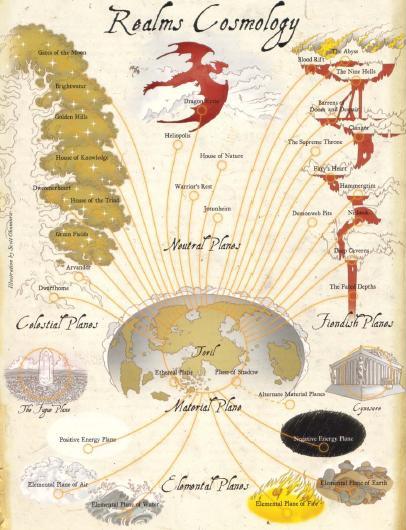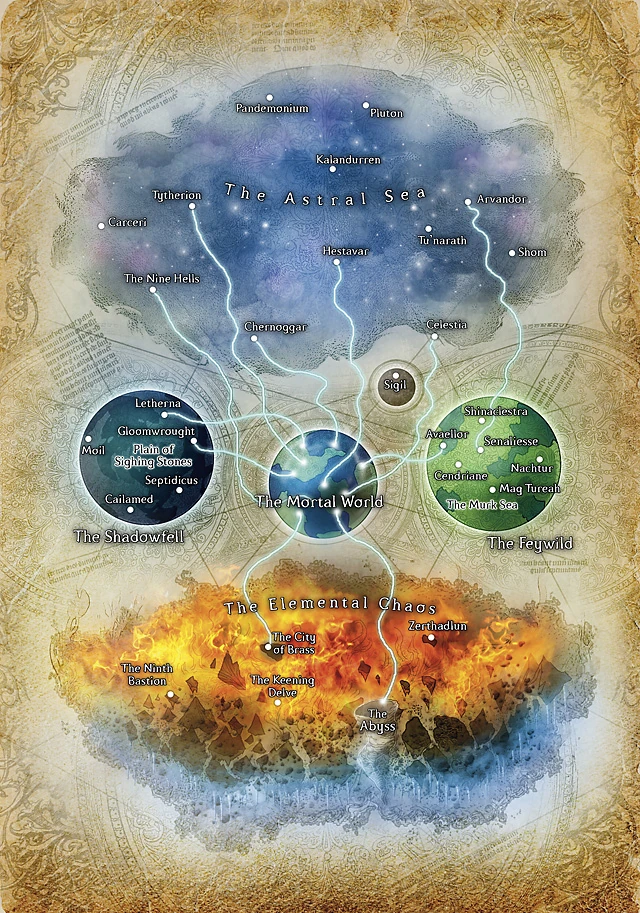The Negative Energy plane, sometimes called the Plane of Death[1] or the Negative Material plane, was an Inner Plane[7] or Energy Plane[12] of the Great Wheel cosmology and the World Tree cosmology models. Cosmologists believe that negative energy and its opposite positive energy, combined with the four elements, make up the known universe.[13] This plane was extremely hostile to all forms of life and energy. Only the undead could travel with impunity here, and the more powerful undead could harness this death energy to attack the living with devastating effect.[1][2] After the Spellplague, the Negative Energy plane collapsed into the Elemental Chaos, mixing with all the other Inner Planes. The goddess Shar managed to channel some of this death energy into the Plane of Shadow and create the Shadowfell.[14][note 1] The Negative Energy plane was restored following the Second Sundering.[11]
Cosmology[]
According to the Great Wheel cosmology model, the Negative Energy plane could be reached via the Ethereal Plane or an adjacent elemental plane, but not by an elemental vortex. (However, there is speculation that the Void card in the deck of many things brought a person here.)[7] If traveling through the Deep Ethereal, a pure black curtain of vaporous color indicated the boundary of the Plane of Death's Border Ethereal region.[15] Such was the influence of the Negative Energy plane that the boundary with the Border Ethereal was weak and fluctuated randomly at times. Travelers thinking they were safe staying in the Border Ethereal could suddenly be dumped on the Plane of Death some distance from the rapidly receding border.[1] Using the spherical model, this plane was adjacent to the quasi-elemental planes of Dust, Ash, Vacuum, and Salt.[16] Temporary gates could be created by the plane shift spell.[17]
As described by the World Tree cosmology model, the Astral Plane connected all planes with the Prime Material Plane and the Ethereal Plane was only used for journeying between locations on the Prime.[18] The Negative Energy plane was not connected or coterminous with any other elemental plane.[19] The spell astral projection [20][21] could be used to reach the Negative Energy plane via a cold ebony color pool.[22] Additionally, the gate [23][24] and plane shift [20][25] spells could be used to open a temporary portal to this plane.
Description[]
It is the heart of darkness.
It is the hunger that devours souls.
Both cosmological models described this plane as being an airless, featureless void of darkness with gravity being an individual choice. Somewhat paradoxically, both models also allow that structures existed on a landscape of sorts, either made of the physical, solid darkness,[1] or perhaps of elemental earth that could survive in regions of the plane (called doldrums) that did not exhibit the major-negative dominance trait.[2] The atmosphere was not vacuum but could not be used by winged creatures for propulsion, nor could it sustain life, yet torches and lanterns would burn for a short while before being extinguished.[2] Magical light sources worked as usual but visibility was extremely limited.[1][2] These characteristics led cosmologists to speculate that it was the energy-sucking nature of the plane that greedily devoured any life-giving energies rather than the complete lack thereof, but the difference is of interest only to sages. In practical terms, without protection from the negative energy and elimination of the need to breathe, death was only a few minutes away at best.
Just as there were areas where the negative energy seemed to recede and create the doldrums, some locations exhibited concentrations intense enough to create stable chunks of solid matter that were dubbed voidstone. These absolutely black blobs ranged from a few inches/centimeters in diameter to the size of a small house and perhaps larger. Anything that touched a voidstone was destroyed in the span of a few heartbeats—even the undead were not immune. This property led scholars to speculate that voidstone may have been a component in the creation of magic items like the sphere of annihilation.[9][2] Another curious and deadly property of these silent death traps was that voidstones of a certain size, not too small and not too large, were attracted to life and would move toward the nearest living creature in jerky, uneven leaps.[9] The exact range of this attraction was unknown because of limited visibility, and all reports of attempted mental control indicated failure.[9][2]
Inhabitants[]
The Negative Energy plane was so inimical to life that, in the time of the Great Wheel cosmological model, the only creatures that had actually been seen in the plane were the inscrutable outsiders, the xeg-yi.[1][26] The "energy vultures" known as trillochs were thought to be from this plane but may not have originated here.[1][27] By the time the World Tree cosmological model became popular it was discovered that undead creatures could survive here and that powerful undead, such as vampires, liches, wraiths, wights, and spectres, made this plane their home base.[2] And where undead are found, necromancers are seldom far behind. The doldrums were best suited for necromantic work but there was always a danger the negative energy would surge and overwhelm the area.[2]
Realms[]
- Null, draconic god of death, had realms named the Mausoleum of Chronepsis and the Mausoleum of Pain in the Outlands and Carceri, respectively. Parts of these were thought to exist on the Negative Energy Plane at the same time.[28]
Appendix[]
Appearances[]
Adventures
Lords of Darkness 1st edition: "Vampires" • Marco Volo: Departure • Tomb of Annihilation
Novels & Short Stories
Gamebooks
Knight of the Living Dead
Video Games
Organized Play & Licensed Adventures
The Rogue of the World • Along the Wheel of Fates • The Guns of Azzagrat: "The Quarry of Ebulon"
References[]
- ↑ 1.0 1.1 1.2 1.3 1.4 1.5 1.6 1.7 Jeff Grubb (July 1987). Manual of the Planes 1st edition. (TSR), p. 54. ISBN 0880383992.
- ↑ 2.0 2.1 2.2 2.3 2.4 2.5 2.6 2.7 2.8 Jeff Grubb, Bruce R. Cordell, David Noonan (September 2001). Manual of the Planes 3rd edition. (Wizards of the Coast), p. 81. ISBN 0-7869-1850-8.
- ↑ Jeff Grubb (July 1987). Manual of the Planes 1st edition. (TSR), pp. 12, 62. ISBN 0880383992.
- ↑ Bruce R. Cordell (1998). A Guide to the Ethereal Plane. Edited by Michele Carter, Keith Francis Strohm. (TSR, Inc.), p. 20. ISBN 0-7869-1205-7.
- ↑ Jeff Grubb, Bruce R. Cordell, David Noonan (September 2001). Manual of the Planes 3rd edition. (Wizards of the Coast), pp. 49, 57. ISBN 0-7869-1850-8.
- ↑ Gary Gygax (August 1983). Monster Manual II 1st edition. (TSR, Inc), p. 60. ISBN 0-88038-031-4.
- ↑ 7.0 7.1 7.2 Jeff Grubb (July 1987). Manual of the Planes 1st edition. (TSR), pp. 22–24. ISBN 0880383992.
- ↑ Jeff Grubb, Bruce R. Cordell, David Noonan (September 2001). Manual of the Planes 3rd edition. (Wizards of the Coast), pp. 6–7. ISBN 0-7869-1850-8.
- ↑ 9.0 9.1 9.2 9.3 Monte Cook, Jonathan Tweet, Skip Williams (July 2003). Dungeon Master's Guide v.3.5. (Wizards of the Coast), p. 157. ISBN 0-7869-2889-1.
- ↑ 10.0 10.1 Jeff Grubb, Bruce R. Cordell, David Noonan (September 2001). Manual of the Planes 3rd edition. (Wizards of the Coast), pp. 80–81. ISBN 0-7869-1850-8.
- ↑ 11.0 11.1 Jeremy Crawford, Christopher Perkins, James Wyatt (December 2014). Dungeon Master's Guide 5th edition. Edited by Scott Fitzgerald Gray, et al. (Wizards of the Coast), p. 43. ISBN 978-0-7869-6562-5.
- ↑ Ed Greenwood, Sean K. Reynolds, Skip Williams, Rob Heinsoo (June 2001). Forgotten Realms Campaign Setting 3rd edition. (Wizards of the Coast), p. 256. ISBN 0-7869-1836-5.
- ↑ Monte Cook, Jonathan Tweet, Skip Williams (July 2003). Dungeon Master's Guide v.3.5. (Wizards of the Coast), p. 148. ISBN 0-7869-2889-1.
- ↑ Bruce R. Cordell, Ed Greenwood, Chris Sims (August 2008). Forgotten Realms Campaign Guide. Edited by Jennifer Clarke Wilkes, et al. (Wizards of the Coast), p. 69. ISBN 978-0-7869-4924-3.
- ↑ Jeff Grubb (July 1987). Manual of the Planes 1st edition. (TSR), p. 12. ISBN 0880383992.
- ↑ Jeff Grubb (July 1987). Manual of the Planes 1st edition. (TSR), p. 52. ISBN 0880383992.
- ↑ David "Zeb" Cook (August 1989). Player's Handbook (2nd edition). (TSR, Inc.), p. 224. ISBN 0-88038-716-5.
- ↑ Monte Cook, Jonathan Tweet, Skip Williams (July 2003). Dungeon Master's Guide v.3.5. (Wizards of the Coast), p. 147. ISBN 0-7869-2889-1.
- ↑ Monte Cook, Jonathan Tweet, Skip Williams (July 2003). Dungeon Master's Guide v.3.5. (Wizards of the Coast), p. 150. ISBN 0-7869-2889-1.
- ↑ 20.0 20.1 Monte Cook, Jonathan Tweet, Skip Williams (July 2003). Dungeon Master's Guide v.3.5. (Wizards of the Coast), p. 151. ISBN 0-7869-2889-1.
- ↑ Jonathan Tweet, Monte Cook, Skip Williams (July 2003). Player's Handbook v.3.5. (Wizards of the Coast), p. 201. ISBN 0-7869-2886-7.
- ↑ Jeff Grubb, Bruce R. Cordell, David Noonan (September 2001). Manual of the Planes 3rd edition. (Wizards of the Coast), p. 49. ISBN 0-7869-1850-8.
- ↑ Jeff Grubb, Bruce R. Cordell, David Noonan (September 2001). Manual of the Planes 3rd edition. (Wizards of the Coast), p. 33. ISBN 0-7869-1850-8.
- ↑ Jonathan Tweet, Monte Cook, Skip Williams (July 2003). Player's Handbook v.3.5. (Wizards of the Coast), p. 234. ISBN 0-7869-2886-7.
- ↑ Jonathan Tweet, Monte Cook, Skip Williams (July 2003). Player's Handbook v.3.5. (Wizards of the Coast), p. 262. ISBN 0-7869-2886-7.
- ↑ Gary Gygax (August 1983). Monster Manual II 1st edition. (TSR, Inc), pp. 128–129. ISBN 0-88038-031-4.
- ↑ Don Turnbull (1981). Fiend Folio. (TSR Hobbies), pp. 89–90. ISBN 0-9356-9621-0.
- ↑ Dale Donovan (January 1998). Cult of the Dragon. Edited by Julia Martin. (TSR, Inc.), p. 121. ISBN 0-7869-0709-6.
Connections[]

Prime Material plane • Feywild • Shadowfell • Fugue Plane
Transitive Planes: Astral Plane • Ethereal plane
Inner Planes: Elemental Plane of Air • Elemental Plane of Water • Elemental Plane of Earth • Elemental Plane of Fire • Elemental Chaos
Para-Elemental Planes: Frostfell • Swamp of Oblivion • Fountains of Creation • Great Conflagration
Quasi-Elemental Planes: Lightning • Radiance • Minerals • Steam • Vacuum • Ash • Dust • Salt
Outlands: Sigil
Outer Planes: Arcadia • Mount Celestia • Bytopia • Elysium • Beastlands • Arborea • Ysgard • Limbo •
Pandemonium • Abyss (Layers) • Carceri • Hades • Gehenna • Nine Hells • Acheron • Mechanus
Energy planes: Positive Energy plane • Negative Energy plane
Planar Pathways: Infinite Staircase • Oceanus • Mount Olympus • Styx • Yggdrasil
Far Realm

Prime Material plane • Cynosure • Fugue Plane
Transitive Planes: Astral Plane • Ethereal plane • Plane of Shadow • Spirit World
Celestial Outer Planes: Arvandor • Brightwater • Dwarfhome • Dweomerheart • Gates of the Moon • Golden Hills • Green Fields • House of Knowledge • House of the Triad
Fiendish Outer Planes: Abyss (Layers) • Barrens of Doom and Despair • Blood Rift • Clangor • Deep Caverns • Demonweb Pits • Fated Depths • Fury's Heart • Hammergrim • Nine Hells • Nishrek • Supreme Throne
Neutral Outer Planes: Dragon Eyrie • Heliopolis • House of Nature • Jotunheim • Warrior's Rest
Inner Planes: Elemental Plane of Air • Elemental Plane of Earth • Elemental Plane of Fire • Elemental Plane of Water • Positive Energy plane • Negative Energy plane
Planar Pathways: Infinite Staircase • River of Blood • World Tree
Far Realm

Prime Material plane
Fundamental planes: Astral Sea • Elemental Chaos
Astral dominions: Arvandor • Banehold • Celestia • Cynosure • Deep Wilds • Demonweb Pits • Dismal Caverns • Dwarfhome • Eternal Sun • Fugue Plane • Gates of the Moon • Green Fields • House of Knowledge • Nine Hells • Nishrek • Supreme Throne • Towers of Night • Tu'narath • Warrior's Rest
Elemental realms: Abyss (Layers) • City of Brass • Cresting Spires • Fimbulwinter • Hidden Realm • Muspelheim • Root Hold • Sky Home • Steading • Thraotor • Undying Pyre • Zerthadlun
Parallel planes: Feywild • Shadowfell
Anomalous planes: Far Realm
Cite error: <ref> tags exist for a group named "note", but no corresponding <references group="note"/> tag was found
